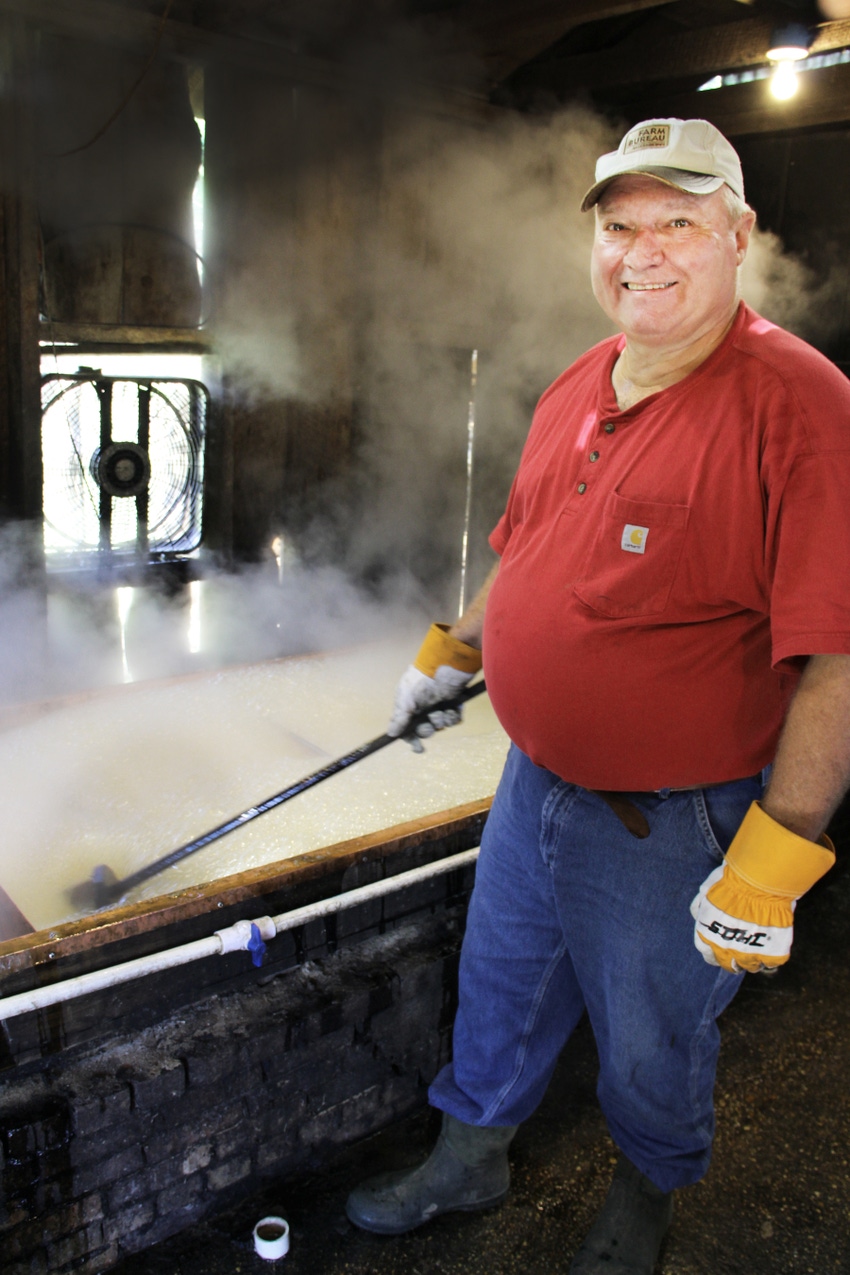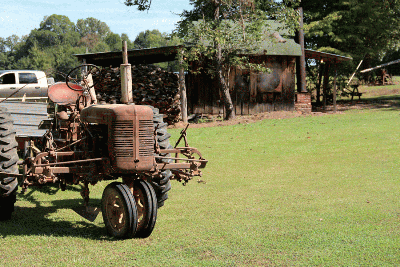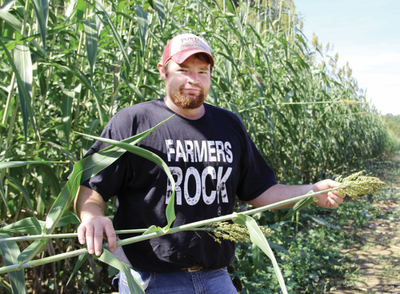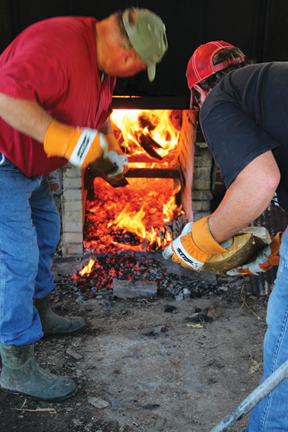
How sweet it is: Syrup-making a fall ritual for Terry Norwood
Follow your nose to a rustic one-room building, its wooden boards darkened with years of smoke from fires hot as the hinges of Hades, where Terry Norwood and his crew are cooking sorghum syrup that, when teamed with real-honest-to-goodness butter and hot homemade biscuits, constitutes what aficionados consider some of the finest breakfast eatin’ on the planet.

Step out of your vehicle at Terry Norwood’s farm on a spectacularly beautiful fall day — stunningly blue sky, bright sun, cool breezes, patches of yellowing soybeans, vines loaded with ripening muscadines, ancient farm equipment scattered thither and yon — and there is in the air a sugary sweetness, somewhat like, but not quite, the smell of cotton candy at the state fair.

EARLY ERA farm equipment frames the syrup shack on Terry Norwood's farm.
Follow your nose down the grassy slope 50 yards or so to a rustic one-room building, its wooden boards darkened with years of smoke from fires hot as the hinges of Hades, where Norwood and his crew are cooking sorghum syrup that, when teamed with real-honest-to-goodness butter and hot homemade biscuits, constitutes what aficionados consider some of the finest breakfast eatin’ on the planet.
Molasses-making in the U.S. dates back to Colonial America, and until the late 1800s the sorghum product was the sweetener of choice because it was so much cheaper than refined granular sugar. But following World War I, the price of the white stuff dropped drastically and molasses-making fell by the wayside — continued today only in scattered demonstrations at historic sites and by traditionalists like Norwood, who traces ‘lasses-making back to his great-grandfather.
Ag news delivered daily to your inbox: Subscribe to Delta Farm Press Daily.
“I’m the fourth generation of my family making syrup,” he says, all the while raking a hoe-like paddle back and forth through the hot, bubbling liquid. Underneath the vats, a blazing fire heats the juice to a steaming froth, and as it moves from one vat to another, some of the water evaporates and the syrup gradually thickens.
“I grew up around this, and (he laughs) it has become something of my fall obsession.”
Early-era equipment

JACOB NORWOOD inspects sweet sorghum stalks that will be crushed for syrup making.
He has made some concessions to modernity: The 15-foot stalks of sorghum are no longer cut by hand with machetes (much to the relief of wife Debbie, who helped him for years), but with a corn binder (they’re deheaded with a tractor-mounted sickle mower), and stalks are no longer crushed by mules tethered to a long wooden pole, plodding around in circles, but by a tractor-towed power crusher.
“I have one of the old mule-drawn mills that’s on display as a curiosity item for visitors to the farm,” Norwood says. “At Christmas, I’ll string lights on it and put it out in the front yard with other holiday lights and decorations. The kids really like to see all our old equipment, and my 1-1/2 year old grandson, Lem Tate, loves for us to let him pretend-drive these machines. Back in the day, Case, John Deere, and International all made sorghum harvesting machinery that was pulled by horses or mules.”
Over the years, he’s bought a number of old mills and related equipment, which he uses for spare parts and to provide interest for those who come to the farm.
After the sorghum stalks are cut with a sickle mower and the seedheads removed, the bundles of stalks stay in the field three to five days to let nature enhance the sugars, after which stalks are fed by hand through the crushing machine right there in the field. Juice is collected in a 300-gallon tank and transported to a cooling shed near the cooking house.
“We transfer it to stainless steel milk coolers,” Norwood says. “Water circulating through coils inside the tanks cools the juice to 38 degrees and holds it at that temperature until we get ready to cook it. We can hold 500 gallons in the coolers. While it’s in the cooling tank, most of the bits of cane pith and other impurities will settle to the bottom. If we didn’t cool it, it would ferment into some pretty potent alcohol — most of the U.S. sorghum crop goes to ethanol production, and of course, it’s used in many parts of the world to make rum.”
He grew 10-1/2 acres of sweet sorghum this year, an M81E variety developed at Mississippi State University. “We also grow 2 acres of sweet sorghum for seed for the university. Their seed is sold to growers all over the world.”
A sellout each year
In a day, Norwood says, “We can make 50 gallons of syrup. On average, it takes 10 gallons of juice to make one gallon of molasses, but the ratio can vary from 9-to-1 to 11-to-1, depending on how the cooking goes on any given day.

HOTTER THAN the hinges of Hades, Terry Norwood says of the cooking fire. He and Jacob Norwood feed the fire with pine slabs.
“We use pine slabs for the fire. In the old days, they used willow, and I have used some oak, but pine produces the really white-hot fire we need. The cooked syrup comes off the vats at 235 degrees. It’s strained to remove any tiny bits of cane pulp or impurities that might have made it through the cooking process. After it cools to 150-160 degrees we bottle it.
“This year, we’ll produce about 500 gallons of syrup, which we package in pints, quarts, and 4-lb. jugs. We used to put it up in cans, but because of food safety regulations, we now put it in space-age plastic jugs with tamper-proof inner seals.
“We sell out of everything we produce each year. A lot of people will come out here when they know we’re cooking and bottling, and a lot stop by on their way to or from Ole Miss home football games. We put signs out on Hwy. 30, just a mile away. We also ship quite a bit to customers around the U.S. and to overseas destinations — I’ve shipped it as far away as Australia.”
Sorghum syrup, in addition to being tasty, is an all-natural, nutritious treat, Norwood says. “It contains iron, calcium, potassium, and phosphorus — all beneficial nutrients.”
His farm is located at Etta on County Route 355, between New Albany and Oxford, Miss. The community, in earlier days, was known as Rocky Ford, a name still used by many of the locals, and the name he uses for his syrup.
“Last year, the Tupelo, Miss., newspaper ran an article and photos about us, and the next morning there were cars lined up in the driveway wanting to buy syrup,” he says.
Although he grew up around syrup-making, Norwood says he didn’t really get involved in it personally until a high school teaching stint at Ingomar, Miss. “My FFA kids had some sorghum projects, and we cooked some syrup.” He laughs, “They weren’t as enthusiastic about it as I was. I bought some equipment and built my cooking shack.
“A guy I knew, David Crawford, taught me a lot about the nuts and bolts of the process. I started making it on my own in 1980, and there hasn’t been a year since that I haven’t done it.”
After his teaching stint, Norwood racked up a lot of miles as a long-distance trucker, hauling U.S. mail over much of the eastern U.S., and for the past 21 years has been a regional manager/commodity coordinator for the Mississippi Farm Bureau Federation.
He is a member of the National Sweet Sorghum Producers and Processors Association, which he says has more than 500 members in the U.S. and several foreign countries.
Syrup making has, over the years, also been something of a social event at his farm, Norwood says, with people dropping in to watch and talk. “Some of the biggest tales you’d ever hear have been told by folks sitting around under the trees while syrup is being cooked,” he says.
About the Author(s)
You May Also Like



